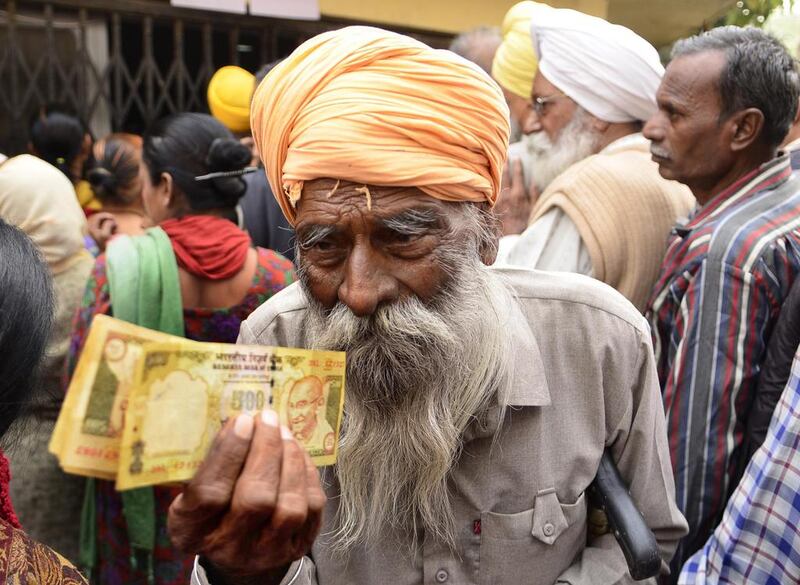Thirty-five-year-old Sheik Basheer set himself on fire in Andhra Pradesh’s Nizamabad town on the afternoon of November 15. Hours later, he made a dying declaration before a magistrate at the hospital: he had tried to exchange high value currency notes demonetised by the Indian government for several hours at several banks, but in vain. Dejected, he had decided to take his own life.
Basheer is one among 55 people who have died in nine days following the Indian government’s November 8 decision to demonetise high value currency notes of 500 and 1,000 Indian rupees (Dh27 and Dh53) – about 80 per cent of the country’s cash is held in these notes. Most are elderly people who have died in the long queues. The actual death toll could be much higher than what’s been reported.
People have until the end of December to exchange the notes for new bills but anything over Rs2,000 must be credited to a bank account. Deposits above Rs250,000 could attract tax plus a 200 per cent penalty in some cases. As a result, Indians are fearful that banks will inadvertently harass honest taxpayers who have traditionally kept money in cash. Compounding the problem? Half of Indians don’t have a bank account. There are stories of people depositing cash in friends and relatives’ accounts, burning now illegal cash piles and others buying gold and other items with their money.
The government claims the move will: tackle the rampant proliferation of black market money; lower cash circulation related to corruption; and eliminate fake currency used to fund terrorism. But only 5 to 6 per cent of black money in the country is held in cash; the major avenues are gold and real estate.
There is yet another crucial agenda the government has in mind vis-à-vis demonetisation – the desire to turn India into a cashless economy. A day after the demonetisation announcement by prime minister Narendra Modi, he reiterated this message. “This one decision will change the way people spend and keep their money. It will take India towards a cashless economy ... It doesn’t merely push the country in that direction, but significantly pushes it,” he said. The significant push, however, hasn’t started well. Although most of the affluent urban population has switched to electronic payments, a vast majority of Indians have now been hit by a crippling paucity of cash.
Prices of agricultural commodities in wholesale markets have plummeted by close to 50 per cent, placing the rural economy in deep crisis; snaking queues are to be seen in every part of the country and social media is rife with accounts of people cutting back on essential food items because they have no cash.
Numbers that lie
A cashless economy can be defined as one in which flow of cash is non-existent and all transactions are operated via electronic channels. This ensures transactions leave a clear trail and helps tackle corruption and unaccounted wealth.
The basic prerequisite for a cashless economy is widespread internet access, which makes electronic payments possible. Data with the Telecom Regulatory Authority of India (TRAI) shows that India, with 342.5 million internet users as of August 2016, stands second only behind China in volume terms. But this high volume covers just 27 per cent of the population and clearly falls way short of what is needed to turn the economy cashless.
The picture gets even bleaker when one takes a closer look at internet access numbers. Out of internet users in the country, 193 million are narrowband subscribers, accessing speeds lesser than the standard 512 kbps. In other words, effective internet penetration in India reaches only 12.3 out of every 100 citizens.
In addition, studies also show the number of internet users cannot be conflated with internet inclusion. One such study – Barriers to Internet Access, carried out by Centre for Communication and Development Studies (CCDS) in 2015 – revealed that less than one-fifth of those living in the low-income areas of Pune used the web, as opposed to industry estimates that 50 per cent of residents are online. The study was one of the first in India to examine the extent of the digital divide in a fast-growing Indian metropolis. The report points to a digitally divided city, and says “digital inequality overlays economic and socio-cultural exclusion in the low-income, resource-poor and diversely-literate communities”.
Not surprisingly, the study found network connectivity and coverage are very poor in slums, and households at the lower end of the wealth index are much less likely to be online than those at the higher end. Education is also strongly correlated with internet use and patterns of use, notes the study. It is these sections of the population, unable to transition to online payments, that have suffered the most due to shortage of cash following the shock demonetisation.
Internet access and use also reduces sharply as one moves into the rural areas, where a vast majority of Indians still reside. According to the latest census figures, 69 per cent of India's 1.2 billion population lives in rural areas. Successive governments have outlined plans to take internet deeper into rural areas but the bulk of this effort has been directed at setting up customer service centres or kiosks, where citizens can access e-governance services.
Sandeep Mertia, a Research Associate at the Sarai Programme of the Centre for Study of Developing Societies (CSDS) in Delhi, says this has brought about a tangible infrastructure shift. In fact, in many places, such kiosks are located right inside panchayat (local self government) offices, thus ensuring they are within easy reach of citizens.
“But their uptake among the rural population remains poor and is most often mediated by a computer operator. The effects of digital technologies, often assumed to be empowering, are very much dependent on local conditions of access,” notes Mertia.
Cultural barriers
Earlier this year, while on a reporting trip to Maharashtra’s Aurangabad district in the west of the country, I found government as well as private banks were refusing to accept digitised land records as valid documents for processing crop loan applications from farmers. This was despite the government’s Digital India programme, which seeks to ensure that all government services, including loans, are available to citizens electronically.
This insistence on physical documents, land records in this case, isn’t an isolated example. Earlier this year, Mertia was helping a student submit his college admission application online during his fieldwork. The website didn’t display any confirmation of receiving the documents, so he resubmitted the files and took screenshots of the webpage, which showed the acknowledgement of successful upload. But the student’s father was still not satisfied and insisted on printing the screenshots.
“He even bought a new A4 paper ream for the telecentre to get the printouts. He said he can’t trust this computer work and wants the proof on paper,” says Mertia.
“Vast sections of our population, especially in the rural areas and the urban poor, are used to the materiality of paper. The materiality of the digital world and its traces and trails is not something they’re familiar with.
“It is difficult for them to trust something they cannot see, touch and hold. We should not expect an overnight change in such materially and culturally situated practices.” Their affinity for cash as opposed to digital transactions is part of this cultural trait.
Numbers on online commerce bear this out. According to a study by the Boston Consulting Group (BCG) titled The Rising Connected Consumer in Rural India, "the amount of actual online commerce in rural India is still small". The study says only eight per cent of commerce in rural areas happens online because of a widespread perception among rural consumers that e-commerce is neither safe nor reliable.
At present, more than 70 per cent of rural Indians use the internet mainly to access social network websites, notes the BCG study. Most of this is on mobile phones and accessed by people who may have never seen a computer, since the computers never reached large parts of rural India. The lack of familiarity with computer infrastructure places rural and urban poor netizens at a disadvantage; they make their way around the internet in commonsensical ways, not knowing how best to use the resource. Government-run training and facilitation centres are not of much help either.
“The government’s digital literacy curriculum does not have anything on the internet except email and Google search ... so it is not surprising to find students who begin accessing the web via Google. Even if they know the destination website’s address (eg www.facebook.com), they type it in Google to get the search results and then click on the link,” says Mertia.
While the Indian government hopes digital transactions in the country will go up due to the demonetisation move, research director at the Bangalore-based Centre for Internet and Society Sumandro Chattopadhyay says this comes at a terrible cost.
“The internet literate affluent sections are adopting various digital financial technologies to tide over the cash crunch in the country. But this is coming at the cost of people who are not connected. The latter are suffering for no fault of theirs,” says Chattopadhyay.
The BCG report quoted earlier says digital transaction will hit US$500 billion (Dh1,836 billion) in India by 2020. Clearly, a lot needs to be done to expand the reach of the internet and digital literacy before that target is achieved at the cost of millions of unconnected Indians.
Aritra Bhattacharya is senior correspondent for The Statesman (Mumbai).





